The Seagate 600 & 600 Pro SSD Review
by Anand Lal Shimpi on May 7, 2013 8:00 AM ESTRandom Read/Write Speed
The four corners of SSD performance are as follows: random read, random write, sequential read and sequential write speed. Random accesses are generally small in size, while sequential accesses tend to be larger and thus we have the four Iometer tests we use in all of our reviews.
Our first test writes 4KB in a completely random pattern over an 8GB space of the drive to simulate the sort of random access that you'd see on an OS drive (even this is more stressful than a normal desktop user would see). I perform three concurrent IOs and run the test for 3 minutes. The results reported are in average MB/s over the entire time. We use both standard pseudo randomly generated data for each write as well as fully random data to show you both the maximum and minimum performance offered by SandForce based drives in these tests. The average performance of SF drives will likely be somewhere in between the two values for each drive you see in the graphs. For an understanding of why this matters, read our original SandForce article.
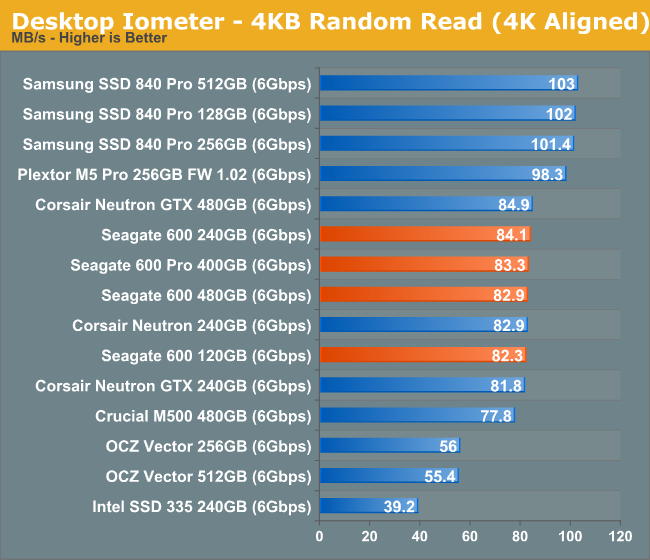
Random read performance is consistent across all capacity points. Performance here isn't as high as what Samsung is capable of achieving but it is very good.
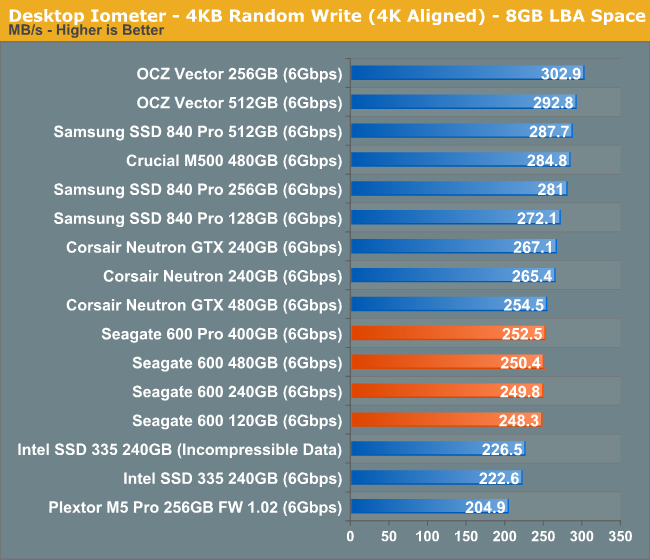
Low queue depth random write performance has just gotten insanely high on client drives over the past couple of years. Seagate doesn't lead the pack with the 600 but it does good enough. Note the lack of any real difference between the capacities in terms of performance.
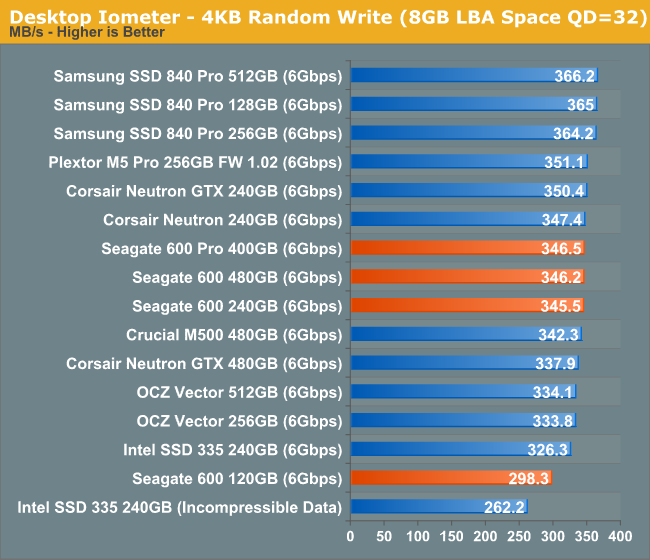
Ramp up queue depth and we see a small gap between the 120GB capacity and the rest. The 600/600 Pro climb the charts a bit at higher queue depths. Note the lack of any performance difference between the 600 and 600 Pro at similar capacities.
Sequential Read/Write Speed
To measure sequential performance I ran a 1 minute long 128KB sequential test over the entire span of the drive at a queue depth of 1. The results reported are in average MB/s over the entire test length.
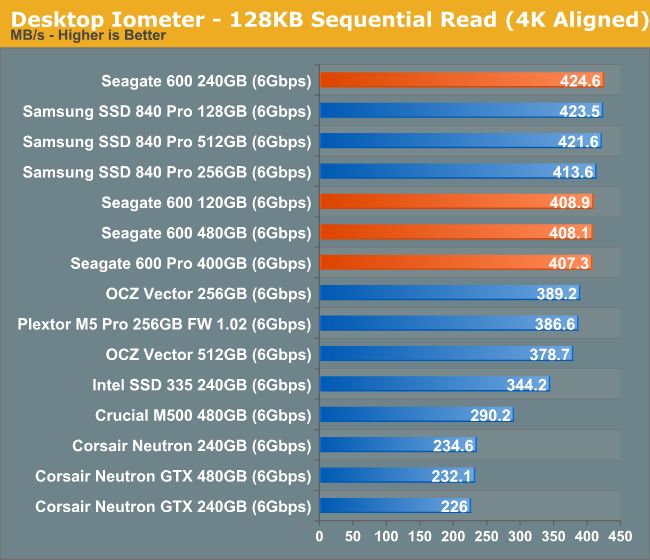
Here's how you tell that Seagate has client drive experience: incredible low queue depth sequential read performance. I'm not sure why the 240GB 600 does so well here, but for the most part all of the drives are clustered around the same values.

Low queue depth sequential writes are also good. The 240GB capacity does better than the rest for some reason. Only the 120GB capacity shows any sign of weakness compared to other class leaders.
AS-SSD Incompressible Sequential Read/Write Performance
The AS-SSD sequential benchmark uses incompressible data for all of its transfers. The result is a pretty big reduction in sequential write speed on SandForce based controllers.
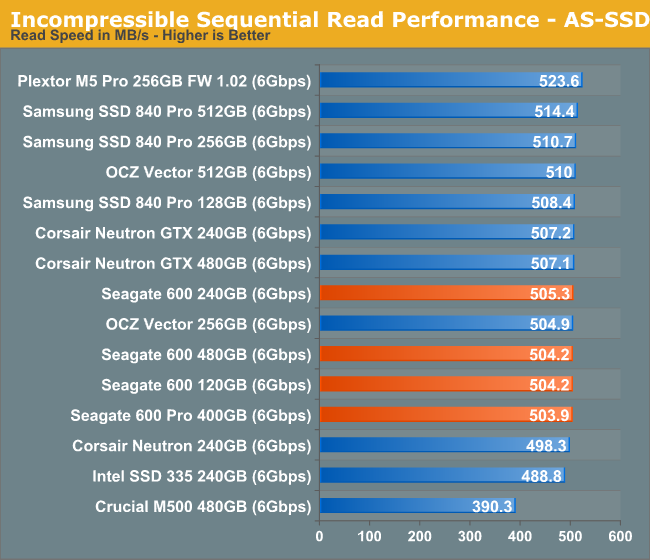
On the read side, at high queue depths we're pretty much saturating 6Gbps SATA at this point. The fastest drive here only holds a 3% advantage over the 600s.
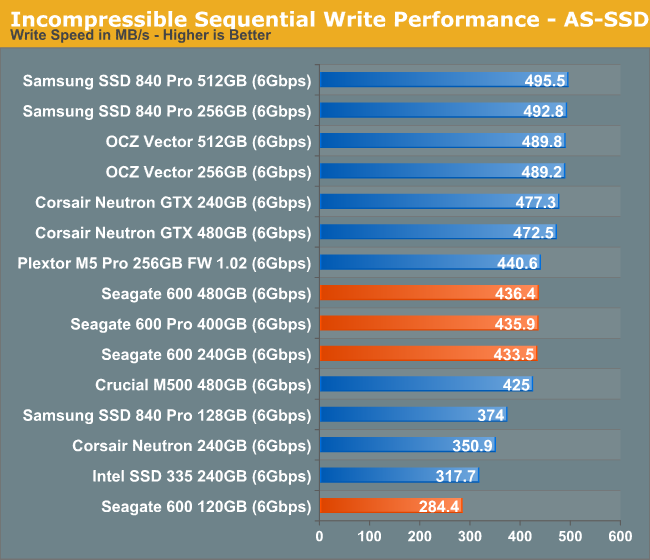
Once again we see solid performance from the 600s. There's no performance advantage to the Pro, and the 120GB capacity is measurably slower.










59 Comments
View All Comments
JDG1980 - Tuesday, May 7, 2013 - link
Personally, I'd be reluctant to go with any brand except Intel and Samsung for SSDs. There have just been too many issues with the other vendors. Maybe Crucial's Marvell-based products, but absolutely not anything based on SandForce - they seem to have more reliability problems than all the other controllers put together.Kristian Vättö - Tuesday, May 7, 2013 - link
Well, Intel's current consumer-grade SSDs are all based on SandForce. In the beginning SandForce definitely had a ton of issues but keep in mind that the SF-2281 is a two-year-old controller - a lot has happened in that time.Then again, I agree that going with something non-SF is better choice because the pricing of SF SSDs isn't exceptionally good (e.g. Samsung SSD 840 is often the cheapest choice). I wouldn't rule out Plextor from the list of good candidates though.
DanNeely - Tuesday, May 7, 2013 - link
Assuming no problems turn up in the next few months I'm probably going to buy a Crucial M500 - 1TB model. I've gone from a $280 120GB SSD to a $330 256GB one and filled both in about 18 months. Skipping the 500GB class entirely should let me go 3 or 4 years before running out of space while also giving enough flash capacity that I can pull my ~200GB of media onto my SSD. As an added bonus this will save ~$100 by allowing me to avoid a precautionary replacement the 5 year old HDD in my system. Overall it's an extra $150 upfront; but will avoid probably spending $300 in 2 years when I'd overflow the smaller SSD and having everything located on a single drive keeps things simpler to admin.Oxford Guy - Wednesday, May 8, 2013 - link
Not true. If you look at slickdeals you'll see SF drives for the same or less than the TLC 840 drives.Shark321 - Tuesday, May 7, 2013 - link
The Destroyer rocks! The first really meaningful SSD test for power users!hp79 - Tuesday, May 7, 2013 - link
For the Seagate 600, did they mistakenly swap the "idle power" usage (1.1W) with the "operating power" usage (0.75W) on the chart?melgross - Tuesday, May 7, 2013 - link
There's really no need for Seagate and WD to be first, or even early. Right now, HDD's are still the main storage component of the industry. Let them observe the mistakes made by others and come up with better products, as this one seems to be. They've got time.James5mith - Tuesday, May 7, 2013 - link
I would still love to see either the older "Optimus" series or the latest 2TB SAS series of SSD's from Smart put through the Anandtech wringer to see how they compare. If it's true that the new 2TB SAS drives are going to be $4000, that's $2/GB for enterprise grade MLC SAS ssds. That's something to take notice of.rms - Tuesday, May 7, 2013 - link
'indirection tablets' this phrase makes no sense to me; a typo? If not, please add an explanatory ellipsis for it!MrSpadge - Tuesday, May 7, 2013 - link
It should be "tables", not "tablets".